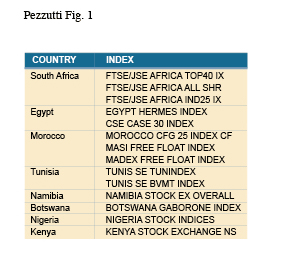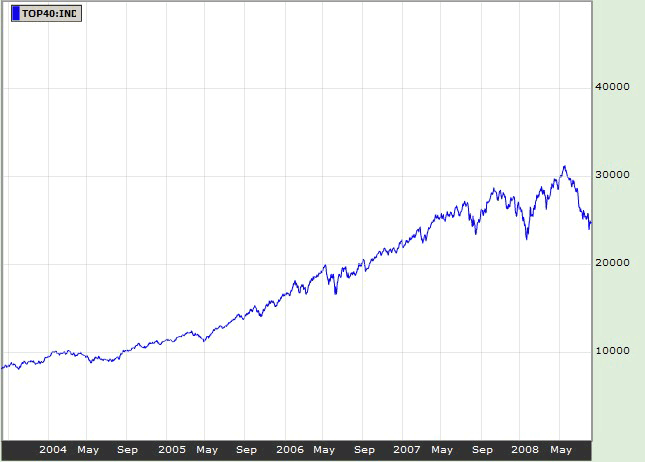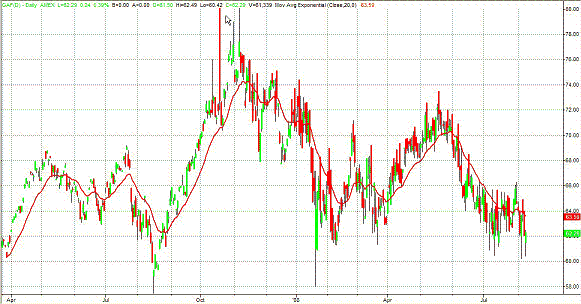
HOT TOPICS LIST
- Strategies
- Stocks
- Buy
- Investing
- Brokers
- Psychology
- Interviews
- Accumulate
- Sell
- Hold
- Spotlight
- Websites
- Candlestick Corner
- Gold & Metals
- Options Trading
LIST OF TOPICS
TRADER'S NOTEBOOK
Investing In Africa
09/09/08 02:15:20 PM PSTby Paulo Pezzutti
Long an underappreciated continent for investment, Africa is on the verge of recognition.
| Africa will play an important role in the global economy of the next decade. As assets move globally in search of low-cost labor and production, Africa will be an actor, and emerging markets in the African countries will, in time, become more representative. In Africa we currently see -- and this will become even more evident in the coming decade -- the US, China, and the European Union compete for the continent's resources. The strategic importance of the continent cannot be underestimated. President Bush's recent trip to Africa is significant from the military point of view because of the prospective US Africa Command (AFRICOM), but also in light of the recognition of the global role that Africa will play. For Africa the journey is long and difficult, with ups and downs at times, and in some countries even dramatic, but the conditions exist for a path of sustained improvement and development. THE ECONOMIC SITUATION However, the general economic situation in Africa shows improvements that should not be underestimated. The number of armed conflicts has diminished. Overall, the governance conditions are improving. Recent growth rates in Africa are very positive. In 2007, real GDP growth exceeded 5% for the fourth consecutive year. Fiscal balance is positive. Various African governments have started privatization programs of state enterprises. Bond duration extension is increasing. GDP per capita is increasing, although poverty rates are still impressively high. Many central banks target inflation, and as a result, inflation has stabilized in recent years and exchange rates are more stable, although there are great concerns on the impact that the increase of food prices and energy could have in the future. At the last Group of 8 meeting in Japan in July 2008, this theme was discussed at length: food and oil prices risk undermine development prospects in Africa. Focusing on sectors critical for reducing poverty such as agriculture, infrastructure, information, and communication technologies would be important. What is driving growth in Africa? It would be common sense to believe that growth is driven by commodity prices. Certainly, this is an important component. Diversifying access to natural resources is strategic for some countries, such as the US (which has a goal to reduce its dependence on Middle East oil by 75%). Demand of natural resources is forecast to increase to such a degree that Africa's great potential is seen as very attractive. African countries have gained from higher metal and soft commodities prices but paid more to import food and energy. In order to understand what is happening, it is important to analyze the foreign direct investment (FDI) trend, which drives economic and social development. Africa has attracted increasing amounts of inward FDI in the past years. FDI inflows rose from $2.4 billion in 1985 to $36 billion in 2006 but remained at the same level in 2007. In many countries, inflows rose mainly in the primary and services sectors because of exploitation of natural resources and ongoing national privatizations. In recent years, higher commodity prices and a more positive climate for investments favored this trend. Infrastructure developments helped as well. A new feature of this trend has been the emergence of countries such as China, India, Russia, Brazil, and South Africa as investors in mining, oil, banking, retail, and telecommunications. However, FDI inflows have not led to an increase in Africa's share of global foreign direct investment. Moreover, FDI is concentrated in a limited number of countries. In 2006, only five countries -- South Africa (24%), Nigeria (13%), Egypt (12%), Morocco (10%), and Tunisia (7%) -- accounted for most of FDI in the region. In some industries, the cost of labor in that area is higher than in India and China. Competitiveness and manufacturing skills must be addressed at the political and international level in order to use revenues coming from the export of natural resources toward education and infrastructure development. This would help improve productivity and attract investments into the manufacturing sector. The picture looks gray; Africa has great unexpressed potential with some good positive points but many problems yet to be solved. We have heard this for the past two decades, but the growing relative importance of access to natural resources could provide impulse to the success of development policies in the continent. |
| AFRICAN FINANCIAL MARKETS The emerging financial markets of African countries such as Botswana, Egypt, Kenya, Morocco, Namibia, Nigeria, South Africa, Tunisia, and others will become, with time, more and more representative, providing good opportunities for investors. In Figure 1 you can see the indexes of the main exchanges listed by Bloomberg. All these markets have shown good performances during the past years. Of course, they have characteristics common to all emerging markets: a limited number of companies traded on the market, low liquidity, and risk of high volatility. But they also offer good opportunities: potential fast-growing economies and markets. Investors should take into consideration these geographical markets for a well-diversified portfolio.
|
| Among these markets there are many differences. For example, the JSE Ltd. (formerly known as the Johannesburg Securities Exchange) is the largest stock exchange in Africa (Figure 2). It has a long history, as it was created in 1887 by Benjamin Minors Woollan. It is a well-developed market for equities and derivatives. Others have been established more recently and have still to fully develop their potential in terms of representing the economy of their country.
|
| HOW DO YOU INVEST IN AFRICA? The prospective investor may be fully aware of risks and opportunities, but it is not easy to find the right financial instrument to invest in Africa. Buying single stocks is out of the question for the average investor. Instead, I would focus on mutual funds, or even better, on exchange traded funds (ETFs). The problem is that a limited number are available at the moment. There are some frontier-market ETFs, but they all are heavily weighted toward Eastern Europe and Middle East. Further, South Africa cannot be considered a frontier market; in fact, frontier markets make up less-accessible and less-liquid equity markets of "preemerging" countries, where investors seek high-return potential and low correlations with more developed markets. In these months, several new financial products are focused on frontier markets. Following are some examples: The Claymore/BNY Mellon Frontier Markets ETF (FRN) uses a passive approach, seeking to replicate the performance of The Bank of New York Mellon New Frontier DR Index. The fund invests in the following African countries: Egypt 17.42%, Nigeria 3.26%, and Ghana, Kenya, Malawi, Mauritius, Morocco, Nigeria, Tunisia, and Zimbabwe. Apart from Egypt and Nigeria, most of the focus is on Eastern Europe and Latin American countries. The SPDR S&P Emerging Middle East & Africa ETF (GAF) seeks to replicate returns of the S&P/Citigroup BMI Middle East & Africa Index (STBMMEU) using a sampling methodology (Figure 3). As of December 31, 2007, the Middle East & Africa Index was composed of 341 stocks.
The fund uses a passive management strategy. As of July 10, 2008, the fund was invested in African companies from Egypt (6.78%), Morocco (8.91%), Nigeria (1.42%), and South Africa (52.82%). Invesco PowerShares launched the PowerShares MENA Frontier Countries Portfolio (PMNA) on July 9, 2008. It tracks the Nasdaq OMX Middle East North Africa Index. The fund is designed to give access to the Middle East and North Africa. The fund country allocation, as far as African countries are concerned, is Egypt (20.6%) and Morocco (13.32%). The fund is for the most part invested in financials (55.1%), telecommunication (19.05%), industrials (12.48%), and materials (10.36%). On July 10, 2008, Dow Jones Indexes launched the Dow Jones Africa Titans 50 Index (DJAFK), which measures the performance of 50 companies traded in domestic stock exchanges in Africa or that generate most of their revenues in Africa with a market capitalization of more than $200 million. As of June 30, 2008, the local exchanges of South Africa, Egypt, Nigeria, Morocco, and Kenya qualified for consideration, but through the index, investors can invest in a pan-African portfolio of companies. Among other countries represented are Angola, DR Congo, Equatorial Guinea, Ghana, Mali, and Zambia. The index will serve as underlying for Market Vectors Africa Index ETF (AFK), which was made available on July 14, 2008, at the New York Stock Exchange. As of July 9, the country allocation had Nigeria at 25%, South Africa 24.7%, Egypt 13.1%, and Morocco 11.4%. Main sectors represented are banks (33.7%), basic resources (18.2%), oil and gas (13.5%), telecommunication (10.2%), and technology (7.3%). A number of specialized mutual funds are available on the market. It is difficult, however, to find some funds where African countries have a meaningful weight. One of them is the T. Rowe Price Middle East & Africa Fund (TRAMX), which was started in September 2007 and invests in markets such as Qatar, the United Arab Emirates, Oman, Jordan, and others. African countries are represented by Egypt (16.4%), South Africa (9.8%), and Nigeria (0.9%) as of September 8, 2008. The sector allocation of the fund is the following: financials (57.7%), industrials & business services (16.5%), materials (15.0%), telecommunication services (6.3%), utilities (2.3%), and energy (0.5%). If you want to invest in South Africa, you have many instruments to choose from, but in this article the frontier markets are my focus. The South African market has seen strong economic growth, thanks to the commodities boom. Many actively managed mutual funds and ETFs offer exposure to the South African market. Some of these instruments are the iShares MSCI South Africa Index fund (an ETF based on the MSCI South Africa Index)(EZA), the Lyxor ETF South Africa (FTSE JSE TOP 40), and the WisdomTree Dreyfus South African Rand Fund (SZR). Others are funds where South Africa has a good weight as a market or in the sector considered, the Franklin Gold and Precious Metals fund, the MFS Emerging Markets Equity fund, and the Pioneer Emerging Markets fund, which invests about 12% of its assets in South African stocks. |
| THE FRONTIER MARKETS Today, it is quite easy for the average investor to access markets that only a few years ago were restricted to a limited number of big investors through popular instruments such as mutual funds and ETFs. Information is more available than it has been in the past, both on the Internet and in specialized publications. As part of the unfolding process of globalization, capitals are moving more freely, searching globally for investment opportunities. Frontier markets present some key characteristics that make them attractive to investors. They focus on countries with a rapid economic growth in terms of GDP and they have low correlation with other markets. Above all, investors look at markets with above-average potential returns, but also above-average potential risk. Among frontier markets, Africa has great opportunity of growth and development, although risk is quite high and the average investor should approach its markets with the idea of long-term investment and diversification. SUGGESTED READING |
PRINT THIS ARTICLE

|

Request Information From Our Sponsors
- StockCharts.com, Inc.
- Candle Patterns
- Candlestick Charting Explained
- Intermarket Technical Analysis
- John Murphy on Chart Analysis
- John Murphy's Chart Pattern Recognition
- John Murphy's Market Message
- MurphyExplainsMarketAnalysis-Intermarket Analysis
- MurphyExplainsMarketAnalysis-Visual Analysis
- StockCharts.com
- Technical Analysis of the Financial Markets
- The Visual Investor
- VectorVest, Inc.
- Executive Premier Workshop
- One-Day Options Course
- OptionsPro
- Retirement Income Workshop
- Sure-Fire Trading Systems (VectorVest, Inc.)
- Trading as a Business Workshop
- VectorVest 7 EOD
- VectorVest 7 RealTime/IntraDay
- VectorVest AutoTester
- VectorVest Educational Services
- VectorVest OnLine
- VectorVest Options Analyzer
- VectorVest ProGraphics v6.0
- VectorVest ProTrader 7
- VectorVest RealTime Derby Tool
- VectorVest Simulator
- VectorVest Variator
- VectorVest Watchdog



